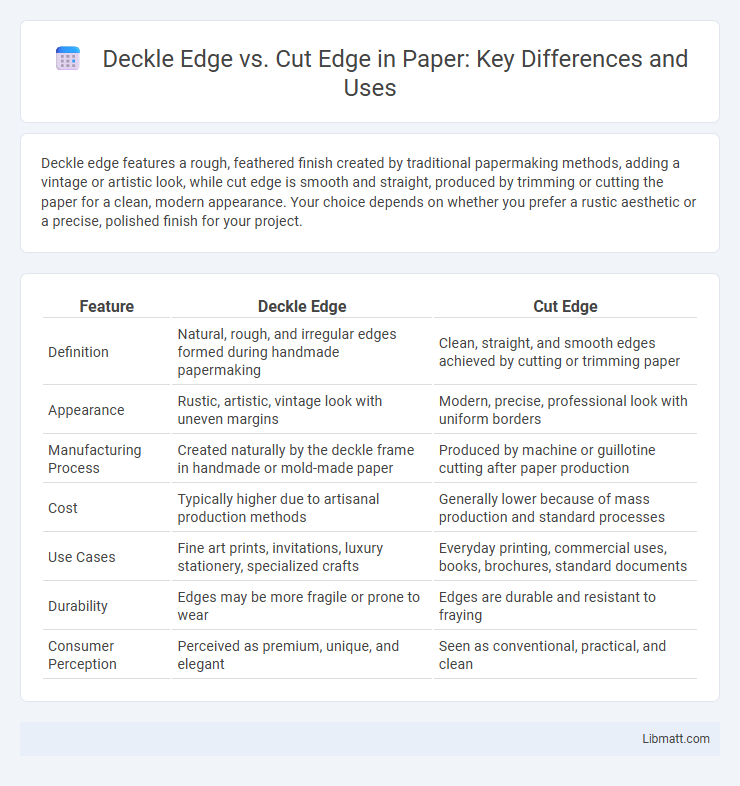Deckle edge features a rough, feathered finish created by traditional papermaking methods, adding a vintage or artistic look, while cut edge is smooth and straight, produced by trimming or cutting the paper for a clean, modern appearance. Your choice depends on whether you prefer a rustic aesthetic or a precise, polished finish for your project.
Table of Comparison
| Feature | Deckle Edge | Cut Edge |
|---|---|---|
| Definition | Natural, rough, and irregular edges formed during handmade papermaking | Clean, straight, and smooth edges achieved by cutting or trimming paper |
| Appearance | Rustic, artistic, vintage look with uneven margins | Modern, precise, professional look with uniform borders |
| Manufacturing Process | Created naturally by the deckle frame in handmade or mold-made paper | Produced by machine or guillotine cutting after paper production |
| Cost | Typically higher due to artisanal production methods | Generally lower because of mass production and standard processes |
| Use Cases | Fine art prints, invitations, luxury stationery, specialized crafts | Everyday printing, commercial uses, books, brochures, standard documents |
| Durability | Edges may be more fragile or prone to wear | Edges are durable and resistant to fraying |
| Consumer Perception | Perceived as premium, unique, and elegant | Seen as conventional, practical, and clean |
Introduction to Deckle Edge and Cut Edge
Deckle edge refers to the rough, feathered edge of handmade or specialty paper, created by the papermaking mold's wooden frame, offering a textured, artistic appearance. Cut edge, by contrast, is the smooth, clean, and precise border produced by trimming machine-cut paper, favored for consistency and a polished finish. The choice between deckle and cut edges influences aesthetics, presentation style, and perceived paper quality in print and bookbinding projects.
What is a Deckle Edge?
A deckle edge is a type of paper finish characterized by its uneven, feathered borders that mimic the natural tearing of handmade paper. This textured, irregular edge is achieved by using a deckle, a frame surrounding a paper mold, resulting in a unique, artisanal appearance. Deckle edges are often sought after for high-quality books, fine art prints, and luxury stationery, offering a distinctive aesthetic compared to smooth, cut edges.
What is a Cut Edge?
A cut edge refers to a clean, straight edge achieved by slicing paper or cardstock with a sharp blade or machine, resulting in a smooth, precise finish ideal for modern and professional designs. This technique contrasts with deckle edges, which have a rough, natural appearance often used for artistic or vintage aesthetics. Understanding the characteristics of cut edges helps you choose the best edge style to enhance the visual appeal and tactile experience of your printed materials.
Historical Context of Paper Edges
Deckle edges originated from traditional papermaking methods where the wooden frame's feathered edges created naturally uneven paper borders, symbolizing authenticity and craftsmanship since the 19th century. Cut edges emerged with industrial papermaking advancements in the 20th century, offering uniform, clean lines preferred for modern publishing and commercial use. Understanding the historical context of deckle versus cut edges can enhance your appreciation of paper texture and the legacy behind its production techniques.
Visual Differences: Deckle Edge vs Cut Edge
Deckle edges exhibit an irregular, feathered appearance with natural, uneven contours that create a vintage or handmade look, often associated with high-quality art prints and fine stationery. Cut edges, in contrast, are smooth, straight, and precise, providing a clean and modern aesthetic typical of most commercially produced paper products. The visual distinction between deckle and cut edges significantly influences the perceived texture and artistry of printed materials.
Tactile and Sensory Qualities
Deckle edge paper offers a textured, organic feel that enhances tactile sensory experience, often associated with luxury and artisanal quality. Cut edge paper provides a smooth, uniform surface that feels sleek and professional, ideal for clean, modern aesthetics. Your choice between deckle edge and cut edge can significantly influence the sensory impression of printed materials, affecting how they are perceived and handled.
Applications in Books and Fine Art Prints
Deckle edge pages offer a distinctive, handcrafted appearance favored in fine art prints and limited edition books, enhancing their collectible value and aesthetic appeal. Cut edge pages provide a clean, uniform finish preferred in mass-produced books and commercial prints for durability and ease of handling. The choice between deckle edge and cut edge significantly impacts the perceived quality and market positioning of books and art prints.
Pros and Cons of Deckle Edge
Deckle edge paper offers a unique, handcrafted appearance that enhances artistic and vintage projects with its irregular, feathered borders, adding visual interest and texture. However, deckle edges can create challenges in uniformity and may not fit standard frames or scanners easily, leading to potential handling difficulties. Your choice depends on whether you prioritize aesthetic appeal and authenticity over precision and ease of use.
Pros and Cons of Cut Edge
Cut edges provide a clean, sharp finish that enhances the clarity and precision of printed materials, making them ideal for professional documents and modern designs. They are less prone to damage and easier to frame or bind, offering durability and practical handling advantages over deckle edges. Your choice of cut edge supports a polished appearance but may lack the artistic, vintage feel that deckle edges convey.
Choosing Between Deckle Edge and Cut Edge
Choosing between deckle edge and cut edge depends on the desired aesthetic and purpose of the printed material. Deckle edges offer a vintage, handcrafted appearance with irregular and textured borders that enhance artistic or luxury prints. Cut edges provide a clean, precise finish suitable for professional documents and modern publications where uniformity and sharpness are prioritized.
deckle edge vs cut edge Infographic

 libmatt.com
libmatt.com